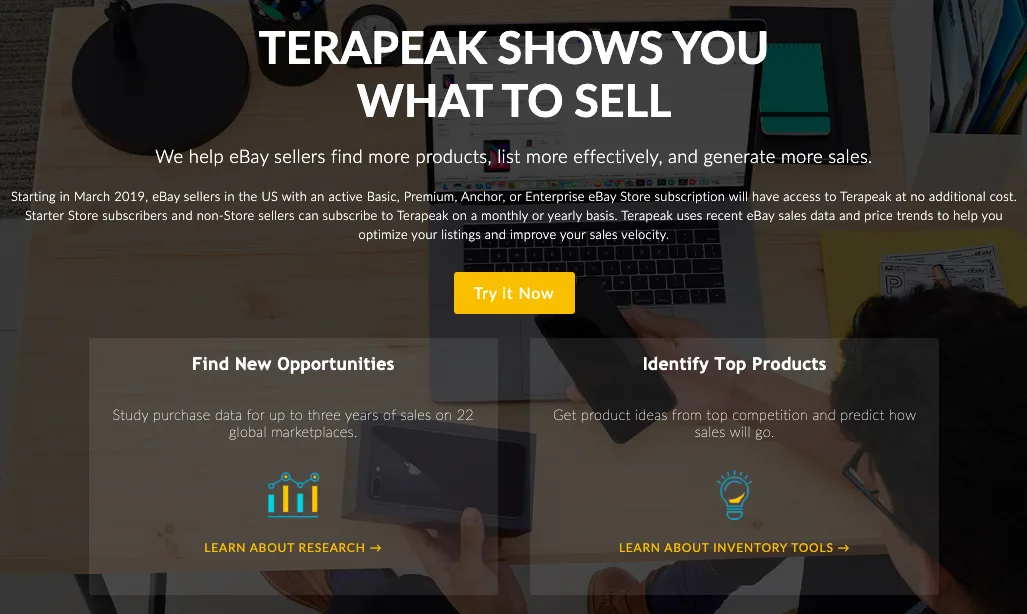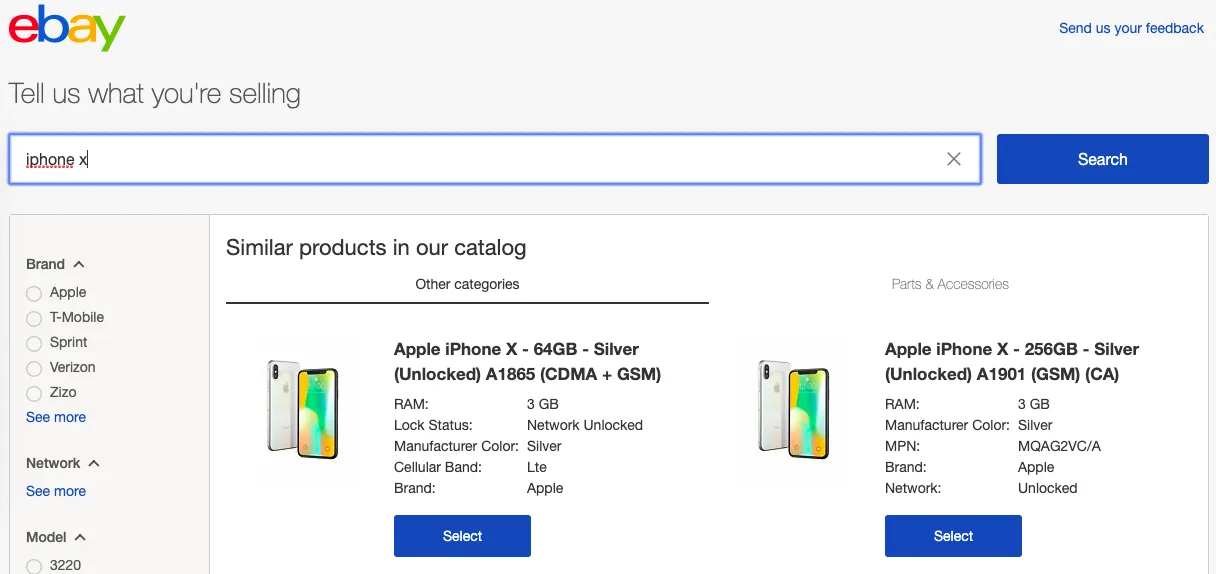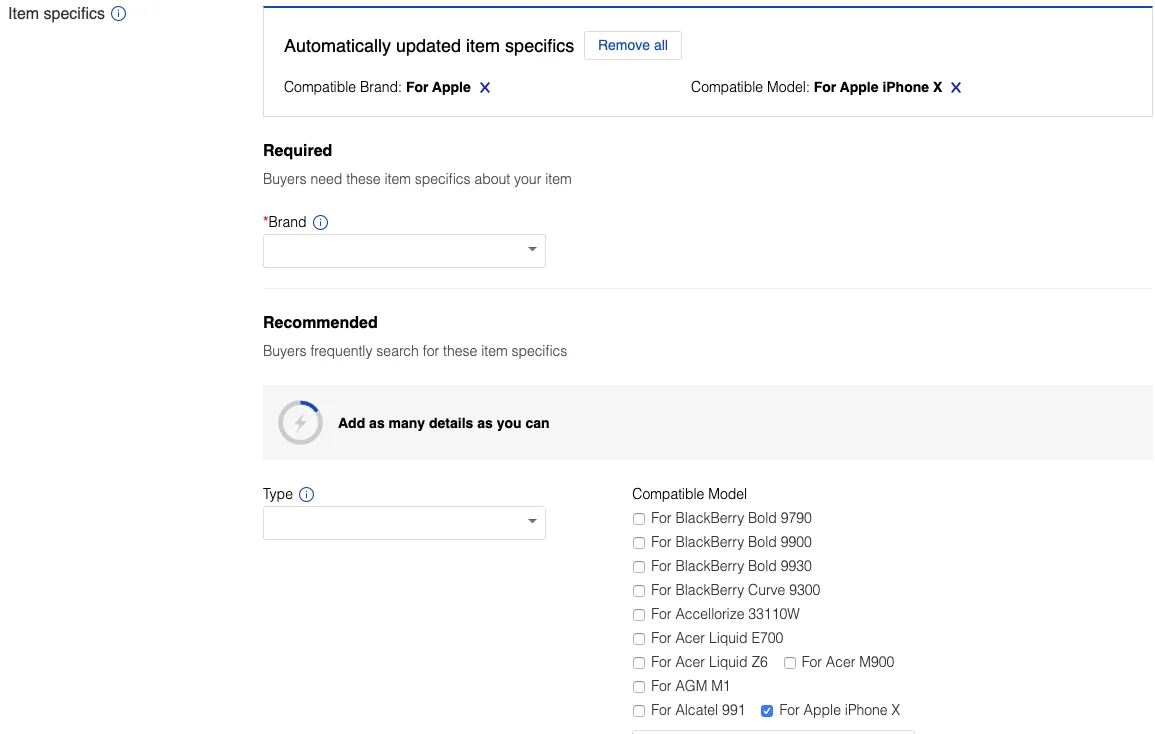How to Start Selling on eBay: Tips for Success
Jason Nadaf

Whether you run a brick-and-mortar retail shop looking to sell online or you’re an individual looking for supplemental income, the consistent growth of ecommerce provides opportunities for reliable revenue streams.
In narrowing down which online avenue to sell on, the impact of marketplaces presents one of the best opportunities for kicking off an omnichannel sales strategy.
eBay is one of the first online marketplaces, and it’s also one of the simplest marketplaces to get started on.
Let’s take a look at how to efficiently get a business set up on eBay that is primed for success.
Researching Products to Sell on eBay
There are a variety of approaches for choosing products to sell online. Unless you have an opportunity to sell products that are heavily discounted and/or unique, it is advised to spend time researching the best and most sustainable product opportunities. Terapeak is a research tool owned by eBay that allows you to access years of real-world sales data for millions of items.
Look for products to source that will give you leverage to make a profit. Targets to aim for include:
Products you can source at a heavy discount,
Unique or scarce products, or
Products that provide a quality alternative to existing marketplace bestsellers.
Other techniques include researching seasonal catalogues for high-margin opportunities and researching products in under-serviced categories by looking at category search volume in relation to the number of available listings.

Once you have a sense for what products to sell and how to source them, it’s time to narrow down the opportunities by considering the logistics.
You need to ensure that you have a complete view of the costs associated with selling online. Depending on the number of products that will be included in your catalogue and how much inventory will be stored, it’s worth researching fulfilment and storage costs.
Once you have gathered dimensions for samples of the products, you can estimate shipping costs by using sites like Uline for packaging and USPS for shipping rates. If you’re considering leasing warehouse space to store inventory, it is worthwhile to research reputable 3PLs to handle inventory storage and fulfilment.
In our experience, just a fraction of a merchant’s online product offerings are responsible for the majority of revenue earned. While catalogue diversity may help with discovery of your best-selling and highest-margin products, keeping it organised in a simple way will remove some of the operational overhead as your business begins to grow.
If you don’t have experience with selling on eBay at this point, it’s worth testing some of your assumptions by launching several listings manually to get a better understanding of how the marketplace operates.
Organising Products to Sell on eBay
Now that you’ve done your research to determine what products you’re going to sell and gain some clarity around the revenue opportunity, you can start to organise your catalogue for easier maintenance.
Assigning SKUs.
To start, we suggest assigning all your products with unique SKUs (stock keeping unit). These can be the manufacturer part number or another common identifier for the product.
The purpose of assigning SKUs is to provide each product with a unique identifier across your catalogue. It also can be used to set the Custom Label/SKU inside eBay’s Selling Manager.
If you are selling products that have variations such as unique sizes and colours, be sure to group these products by a single parent SKU so you are ready to create variation listings on eBay.
Maintaining inventory.
If you have products that will be sold more than once or at volume, it is critical that you maintain accurate inventory levels on your listings.
Overselling products is one of the most common ways for sellers to lose their reputations online. Consider investing in an inventory management platform as soon as you start seeing sales traction — especially if you are selling on other sites or marketplaces in addition to eBay.
Assigning business policies and shipping.
Next, be sure to take advantage of eBay business policies for setting up profiles for shipping, payments, and returns. The more products you are selling, the more granular segmentation you may want for your catalogue and policies.
For example, let’s say you’re just selling a couple dozen SKUs. You could organise them into simple high-level buckets like product category or brand and be able to manage all product listings with a single set of payment and return policies.
Shipping setup will have a significant impact on the profitability and success of your eBay listings. Offer free shipping when possible for higher conversions, and consider the common tactic of building shipping costs directly into product pricing.
From your logistics research, you should be able to assign a set of shipping profiles that accommodate your entire catalogue. Keep these profiles simple to start and, as your business grows, you’ll have opportunities to refine these policies for maximum profit and success.
Gathering assets and listing products.
Aside from organising critical aspects of your product catalogue, consider further segmenting by:
Product category or item specifics.
Product brand or manufacturer.
Product distributor or wholesaler.
Shipping profile or other logistics.
Product cost or expected margin.
Now you’re ready to start gathering product assets to create listings. Whether the products for sale are widely available, newly released, or custom, will determine if you will be able to list via the eBay product catalogue or if you’ll need to source the data elsewhere.
In either case, here’s the information you’ll need to have on each of your products:
Universal identifier such as UPC, EAN, or ISBN.
Product brand name and MPN (manufacturer part number).
Product title (even when listing via a product catalogue, it will help to confirm matches).
Product price.

For products that aren’t in the eBay product catalogue, you’ll have to gather more information:
Product category and category on eBay with item specifics.
Once you’ve determined the eBay category, you’ll learn which specifics are required and recommended.
Fill out recommended item specifics for better search visibility.
Product description.
Product images (either sourced from the manufacturer or by taking photos).
Product weight and dimensions (to populate calculated shipping requirements).

Once you’ve gathered your product data and set pricing and business policies, you are ready to create product listings.
If this is your first time listing and your catalogue contains products across many different categories, you may want to try listing a single product in each category and create selling templates.
If you are selling more than a few dozen products, you may want to consider listing via third-party software or trying eBay’s bulk listing tools.
Optimising eBay Listings
Now that you’ve listed your products and hopefully received a few orders, you may be wondering how you can increase sales.
There are many factors that impact your growth — many of which are related to product listings, especially if you’re not listing via the eBay product catalogue. Feedonomics can help you find everything you need to know about optimising eBay’s promoted listings. Here are some other aspects of your listings that may benefit from optimisation:
Product title.
Consider programmatically generating titles that are user friendly; for example, Brand + Title + Part Number (or other specifics).
When selling products that have many configuration options, consider including them. For example, if you are selling mobile phones, include the wireless carrier and other specifics of the phone model for sale.
Product pricing.
Research your competition so you know your products are priced competitively compared to other listings.
Offer free same-day or next-day shipping.
Buyers’ expectations are only increasing. Consider offering free shipping, and build shipping costs into product pricing when possible. You may rank higher in searches when you offer fast and free fulfilment.
Product item specifics.
While many item specifics are required, taking the time to also set recommended ones will lead to significantly more appearances in buyer searches.
Product photos.
If you’re using manufacturer photos that don’t clearly describe the product, adding high-quality photos will improve your listings and differentiate you from the competition.
Succeeding on eBay
There is more to being successful on eBay than just selling the right products and optimising your product listings. Some are factors within your control, while others may require navigating relationships with eBay for accelerating your marketplace sales.
Earning and maintaining seller reputation with positive feedback.
Your first sales on eBay will be the most critical to gaining traction. To start, make sure you fulfil orders quickly and on time and are packing items securely. And, once again, be sure to maintain accurate inventory levels so you do not oversell products.
Consider including additional packing materials alongside the packing slip like a thank you note, or a flyer with discounts or product information to help differentiate your brand. Once shipped, be sure to immediately mark orders shipped on eBay so your buyers are notified.
Positive reviews are among the quickest ways to build your seller reputation. Once you’ve confirmed the customer has received the package, request their feedback right away. To do this, you can include a request on packing slips, send the buyer a message after the sale, or leverage third-party software that automates requests.
Automating ecommerce operations.
Depending on the products you’re selling and how they are being sourced, there may be aspects of your operations that will be time-consuming and error-prone.
For example, if you’re sourcing products from a third-party wholesaler or manufacturer, there may be operational overhead in generating purchase orders to order or re-order products for sale. Inventory control and order fulfilment — the two most critical aspects to maintaining seller reputation — can also cause challenges.
Automation can help reduce the risk of error and the opportunity cost in the effort spent. While you may not need to be concerned with automation when you first start selling on eBay, it’s never too early to consider what processes will be your most time-consuming and at highest risk for error.
You may want to evaluate third-party shipping software to help automate shipment and label creation — especially if your catalogue is diverse and your customers’ shipping preferences are, too.
To manage your purchase orders for suppliers, it may be worth investing in software that uses your eBay order data to automate sending purchase order emails or submitting order forms to third-party websites.
Accelerating growth.
If you’ve successfully executed the steps above and are generating new sales on eBay, you may still encounter common barriers to accelerating your growth.
One of those barriers is eBay selling limits. As a brand new business and online seller, there may not be many avenues for bypassing these limits without first earning a reputation over time. However, eBay may make exceptions on a case-by-case basis, like if your business has already earned a reputation on other channels or offers exclusive, high-demand products.
If your business and/or product line meets these requirements, you can work with a third party that has strategic relationships with eBay (such as SureDone), and they can help to change these limits in a favourable way.
Another aspect that may hinder potential growth on eBay is the upfront investment from fees associated with creating new listings, especially if you are working with a larger catalogue. Here are a few possible ways to counter these fees:
Consider subscribing to eBay Stores to get a number of free listings included.
Look into special programs offered through various eBay software partners that can waive listing fees.
Watch for periodic offers from eBay for zero insertion fees and take advantage of them when they occur.
Conclusion
We’ve outlined numerous strategies to aid with determining what products to sell, minimising selling costs, building and maintaining seller reputation, and leveraging automation. But we’re still just scratching the surface.
It’s important to do your research when selling on marketplaces so there are no surprises. We encourage you to go further and learn more from other successful sellers, through speaking to vendors, and by asking many questions around best practices for selling online.

Jason Nadaf is the Founder and CEO of SureDone. He is dedicated to the evolution of internet technology which serves as a basis for his experience in implementing complex e-commerce systems encompassing the full range of product, inventory and order management with integration to enterprise systems. With over 25 years of experience in retail, he is obsessed with providing experiences that help people save time and improve efficiencies using the Internet.


